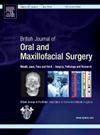人工智能在基于磁共振成像的颞下颌关节疾病检测中的作用:系统综述。
IF 1.9
4区 医学
Q3 DENTISTRY, ORAL SURGERY & MEDICINE
British Journal of Oral & Maxillofacial Surgery
Pub Date : 2025-04-01
DOI:10.1016/j.bjoms.2024.12.004
引用次数: 0
摘要
本系统综述旨在评估人工智能(AI)在磁共振成像(MRI)识别正常或颞下颌关节紊乱(TMD)个体颞下颌关节(TMJ)椎间盘位置中的应用。数据库检索Pub med、谷歌scholar、Semantic scholar、Cochrane,检索AI在MRI中检测颞下颌关节盘位置的研究,截止到2023年9月,遵循PRISMA指南。数据提取包括患者数量、TMJ/MRI数量、AI算法和性能指标。使用改良的PROBAST工具进行偏倚风险评估。纳入7项研究(深度学习= 6,机器学习= 1),敏感性值(n = 7)范围为0.735 ~ 1,特异性值(n = 4)范围为0.68 ~ 0.961。人工智能的准确率超过83%。MobileNetV2和ResNet提供了更好的性能指标。机器学习的准确率最低,为74.2%。偏倚风险分别为低(n = 6)和高(n = 1)。深度学习模型为基于人工智能的MRI颞下颌关节盘位置检测提供了可靠的性能指标。未来的研究需要更好的标准化设计和一致的报告。本文章由计算机程序翻译,如有差异,请以英文原文为准。
Role of artificial intelligence in magnetic resonance imaging-based detection of temporomandibular joint disorder: a systematic review
This systematic review aimed to evaluate the application of artificial intelligence (AI) in the identification of temporomandibular joint (TMJ) disc position in normal or temporomandibular joint disorder (TMD) individuals using magnetic resonance imaging (MRI). Database search was done in Pub med, Google scholar, Semantic scholar and Cochrane for studies on AI application to detect TMJ disc position in MRI till September 2023 adhering PRISMA guidelines. Data extraction included number of patients, number of TMJ/MRI, AI algorithm and performance metrics. Risk of bias was done with modified PROBAST tool. Seven studies were included (deep learning = 6, machine learning = 1). Sensitivity values (n = 7) ranged from 0.735 to 1, while specificity values (n = 4) ranged from 0.68 to 0.961. AI achieves accuracy levels exceeding 83%. MobileNetV2 and ResNet have revealed better performance metrics. Machine learning demonstrated the lowest accuracy 74.2%. Risk of bias was low (n = 6) and high (n = 1). Deep learning models showed reliable performance metrics for AI based detection of temporomandibular joint disc position in MRI. Future research is warranted with better standardisation of design and consistent reporting.
求助全文
通过发布文献求助,成功后即可免费获取论文全文。
去求助
来源期刊
CiteScore
3.60
自引率
16.70%
发文量
256
审稿时长
6 months
期刊介绍:
Journal of the British Association of Oral and Maxillofacial Surgeons:
• Leading articles on all aspects of surgery in the oro-facial and head and neck region
• One of the largest circulations of any international journal in this field
• Dedicated to enhancing surgical expertise.

 求助内容:
求助内容: 应助结果提醒方式:
应助结果提醒方式:


